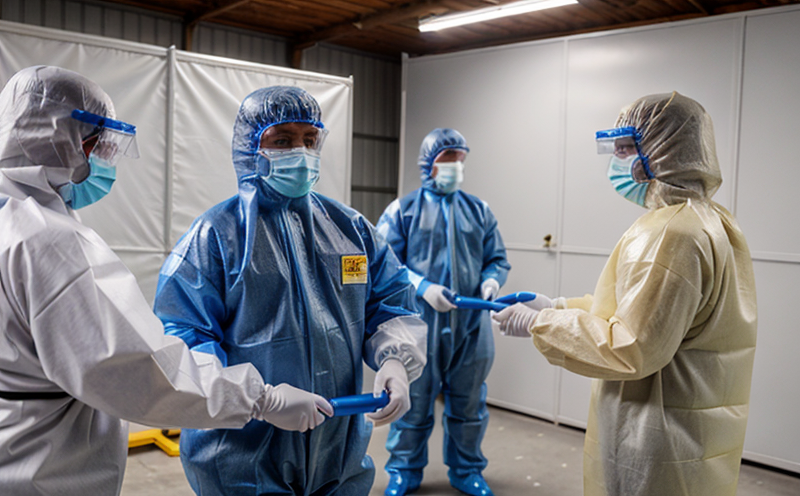ASTM F1930 Manikin test for burn injury prediction in safety garments
The ASTM F1930 standard provides a methodology to predict burn injuries that may occur to the human body when exposed to radiant heat. This manikin-based testing procedure is particularly relevant for assessing protective clothing used by workers in high-risk environments such as fire fighters, military personnel, and industrial workers.
The primary goal of this test is to evaluate the performance of safety garments under simulated burn conditions. The ASTM F1930 standard specifies a full-scale manikin that can be exposed to radiant heat sources to simulate real-world scenarios where an individual might encounter intense thermal radiation. This approach allows for a more accurate prediction of burn injuries than simple calorimetric methods.
During the test, the manikin is placed in a controlled environment and exposed to various levels of heat flux from a radiant heat source. The exposure time can be adjusted depending on the specific conditions under which the garment will be used. After the exposure period, the manikin is inspected for signs of burn injury such as blisters or burns.
The ASTM F1930 standard also provides criteria for acceptable levels of burn injuries based on the heat flux and exposure time. These criteria are designed to ensure that protective clothing meets minimum standards for protection against thermal hazards. Compliance with these criteria can provide confidence in the garment’s ability to protect wearers from severe burns.
Another key aspect of ASTM F1930 is its focus on improving the accuracy of burn injury prediction. By using a full-scale manikin, this test provides more realistic conditions than simpler testing methods that rely solely on calorimetric measurements. This allows for a better understanding of how clothing performs in real-world situations and helps manufacturers develop garments that offer optimal protection.
The ASTM F1930 standard is widely recognized as an important tool for ensuring the safety and effectiveness of protective clothing. It provides a standardized method for evaluating burn injuries, which can help improve product design and increase worker safety. Compliance with this standard is often required by regulatory bodies and industry associations to ensure that protective clothing meets minimum safety standards.
The test procedure described in ASTM F1930 involves several key steps. First, the manikin must be prepared according to the specified guidelines, which include setting up the heat source and ensuring proper ventilation. Then, the manikin is exposed to radiant heat for a predetermined period of time. After exposure, the manikin is inspected for signs of burn injury.
The results of this test are critical for assessing the performance of protective clothing in high-risk environments. By predicting burn injuries accurately, ASTM F1930 helps ensure that workers have the best possible protection against thermal hazards. This can lead to improved safety outcomes and reduced incidents of severe burns among those working in hazardous conditions.
Compliance with ASTM F1930 is essential for manufacturers seeking to produce reliable and effective protective clothing. By adhering to this standard, companies can demonstrate their commitment to worker safety and contribute to the development of safer products.
Why It Matters
The ASTM F1930 manikin test is crucial for ensuring that protective clothing provides adequate protection against burn injuries. By predicting the extent of potential burns, this test helps manufacturers design garments that can withstand high levels of thermal radiation without causing harm to the wearer.
- Ensures consistent performance across different batches of products
- Improves worker safety by providing reliable data on garment effectiveness
- Promotes innovation in protective clothing technology through rigorous testing standards
- Facilitates regulatory compliance, which is often required for workplace safety
- Aids in the development of better training programs for workers using hazardous materials or equipment
The importance of ASTM F1930 cannot be overstated. It serves as a benchmark for evaluating protective clothing’s ability to protect against thermal hazards, thereby enhancing overall worker safety and reducing the risk of severe burn injuries.
Quality and Reliability Assurance
Quality assurance in ASTM F1930 involves meticulous preparation and execution of the test. This includes selecting appropriate materials for the manikin, ensuring accurate calibration of heat sources, and maintaining consistent environmental conditions during testing.
- Selecting high-quality materials ensures that the manikin accurately represents human physiology
- Accurate calibration of heat sources is essential to ensure consistent exposure levels
- Maintaining controlled environmental conditions helps eliminate variables that could affect test results
In addition, regular calibration and validation checks are necessary to maintain the reliability of the testing process. These measures help ensure that the results obtained from ASTM F1930 tests are accurate and repeatable.
Reliability assurance in this context also involves thorough documentation of each test run. This includes recording all relevant parameters such as heat flux, exposure time, and any observed burn injuries. Such detailed records allow for retrospective analysis and continuous improvement of the testing process.
Competitive Advantage and Market Impact
Compliance with ASTM F1930 can provide significant competitive advantages in the market by demonstrating a commitment to worker safety and product quality. This standard sets clear benchmarks for protective clothing manufacturers, ensuring that their products meet stringent performance criteria.
- Maintains a strong reputation among customers who prioritize safety
- Facilitates easier compliance with regulatory requirements
- Promotes innovation in protective clothing technology through rigorous testing standards
- Aids in the development of better training programs for workers using hazardous materials or equipment
In today’s competitive market, companies that prioritize worker safety and product quality are more likely to gain customer trust and loyalty. By adhering to ASTM F1930, manufacturers can position themselves as leaders in their field, attracting customers who value these qualities.
The impact of ASTM F1930 extends beyond individual companies; it also contributes to broader industry standards and best practices. As more organizations adopt this standard, the overall level of worker safety improves, leading to reduced incidents of severe burn injuries and enhanced productivity across industries.





